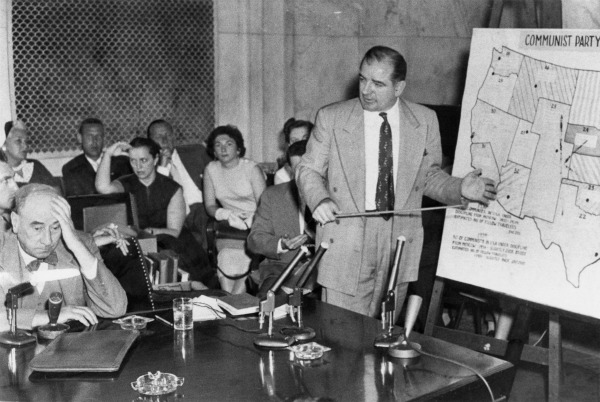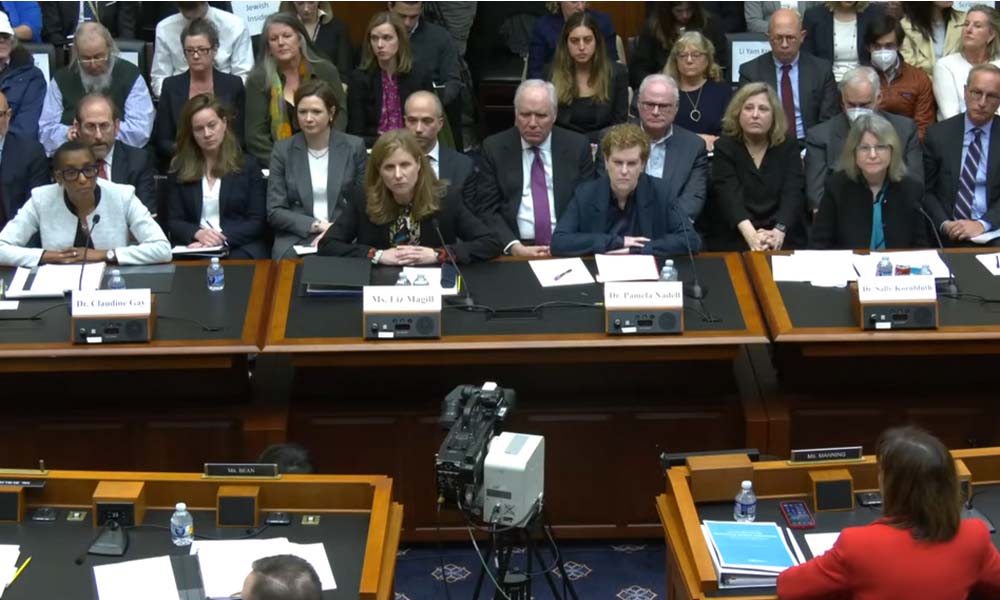A congressional hearing is never fertile ground for nuance, but two college presidents’ recent attempts to parse out degrees of campus antisemitism cost them their jobs—and raised cries of “McCarthyism.” A third president, Nemat (Minouche) Shafik of Columbia University, saw what happened to Claudine Gay of Harvard and Elizabeth Magill of the University of Pennsylvania and prepared accordingly. When asked at her April 17 hearing whether calls for genocide against Jews violated Columbia’s code of conduct, Shafik quickly answered “Yes, it does.” That was a sharp contrast to Gay’s now-famous answer to the same question: “It depends on the context.”
But advocates of vigorous academic freedom still complained that Shafik’s testimony amounted to unnecessary appeasement. “We are witnessing a new era of McCarthyism where a House Committee is using college presidents and professors for political theater,” Irene Mulvey, president of the American Association of University Professors, told The New York Times. “They are pushing an agenda that will ultimately damage higher education and the robust exchanges of ideas it is founded upon.”
“I could answer the question exactly the way you want, Mr. Chairman,” said screenwriter Ring Lardner Jr. “But if I did, I would hate myself in the morning.”
Of course, at the same time Shafik was testing her conciliatory approach to Congress, students at Columbia set up a “Gaza Solidarity Encampment” on campus. Top congressional questioner Elise Stefanik, Republican representative from New York and herself a Harvard grad, charged Shafik with failing to keep students safe and called for her to resign. Shafik then tried a strong-arm approach and called police to clear the student encampment, after which it redoubled and later moved to occupy Hamilton Hall on campus (which police cleared out April 30). Other Republicans in Congress and in statehouses have picked up the beat, condemning the protests and calling for deportations of foreign students who are “brazenly” supporting Hamas, as Stefanik put it.
But does any of this pressure on college administrators amount to a resurgence of McCarthyism? To be sure, Republican wrath in the House reflects a search for political advantage through attacks on “woke” targets. The college presidents, with their nuanced answers to Stefanik’s rapid-fire “Yes or no!” questions, were easy bowling pins to knock down. More broadly, the party’s House Freedom Caucus is less interested in “subversion” à la the 1950s than in vanquishing non-MAGA Republicans who oppose the dominance of Donald Trump.
For those who are used to hearing McCarthyism thrown around as a generalized term of abuse, it may be worth looking back at the details of that time. What we know today as McCarthyism actually began in the late 1930s, just before World War ll, with the House Committee Investigating Un-American Activities chaired by Democratic Representative Martin Dies of Texas. Its mission was to uproot “subversives” on both the extreme left (Communists) and extreme right (Nazis, members of the KKK). It won notoriety early on for including Hollywood star Shirley Temple, then age 10, on a list of communist sympathizers.
The Dies Committee, as it was known, morphed into the House Un-American Activities Committee (HUAC). In 1947 it launched a high-profile investigation of Hollywood, focused on directors and writers with left-wing sympathies. The “Hollywood 10,” as they came to be known, cited First Amendment rights in refusing to answer what became the infamous question: “Are you now, or have you ever been, a member of the Communist Party?” Answering yes obligated the witness to “name names,” i.e. inform on others whom the witness knew to be Communists past or present. Refusing to answer meant being placed on the unofficial “blacklist” and likely never working again in one’s chosen profession. It also virtually guaranteed a contempt citation and likely prison time.
“I could answer the question exactly the way you want, Mr. Chairman,” said screenwriter Ring Lardner Jr. “But if I did, I would hate myself in the morning.” Lardner served a year in prison for contempt of Congress, as did others in the Hollywood 10.

Alger Hiss, State Department official accused of espionage
HUAC’s sensational investigation of State Department official Alger Hiss turned into an epic headline-grabbing morality play. Accused of spying for the Soviet Union, the erudite Hiss served three and a half years in prison for perjury, not espionage. (He maintained his innocence until his death in 1996.)
Wisconsin Senator Joseph McCarthy, a relatively obscure Republican when Hiss was convicted, used the case to raise his political profile. (The Hiss affair also put California Republican Rep. Richard Nixon on the map). In 1950, McCarthy delivered a bombastic speech in which he held aloft a list of names of State Department employees who he claimed were members of the Communist Party USA. McCarthy subsequently won control of the Senate Permanent Subcommittee on Investigations. With New York lawyer Roy Cohn and a young Robert F. Kennedy at his side, McCarthy launched an all-encompassing assault on alleged Communist influence in government. McCarthy became famous for using smear and innuendo to attack panels of government officials. But McCarthy’s most sensational investigation came in 1954, focusing on the U.S. Army. McCarthy’s and Cohn’s hackles had been raised by the Army’s refusal to give preferential treatment to a youthful McCarthy staffer, G. David Schine, a drafted Army private.
After the rebuff, McCarthy went full-throttle, escalating his probe into what came to be called the “Army-McCarthy hearings.” After 36 days and 32 witnesses, the subcommittee found no evidence of any form of Communist influence in the Army. The coda for McCarthy’s career as a Communist hunter was the famous admonition of Boston lawyer Joseph Welch: “Have you no sense of decency, Sir? At long last, have you left no sense of decency?” The Senate voted to censure McCarthy in December 1954. He went into a tailspin of morphine addiction and alcoholism and died in 1957.

McCarthy-Army hearings, June 9, 1954.
McCarthy’s most prominent link to the modern era is through Cohn, who dominated the legal scene in New York for decades post-McCarthy and helped up-and-coming real estate mogul Donald Trump develop a scorched-earth approach to business, which Trump later carried into the world of politics.
Taking all this into account, it is a stretch to characterize today’s congressional scrutiny of college presidents and campuses as all-out McCarthyism. Yes, two of them, Gay and Magill, lost their jobs after their lawyerly answering of questions before the House Committee on Education & the Workforce. But they did not suffer complete professional ruin: Despite public humiliation and damage to their reputations, each returned to their previous professorial positions with no significant loss of pay. In comparison, the McCarthy-era blacklist affected wide swaths of the population, from New York City school teachers who refused to sign loyalty oaths to blue-collar workers in left-leaning unions booted out of the Congress of Industrial Organizations (CIO, pre-merger with the American Federation of Labor, or AFL) to gay people in government who were fired automatically as security risks. At least one actor, Philip Loeb, who was Jewish, committed suicide.
By contrast, the congressional tongue-lashing of college professors has done little other than draw the line between administrators and student protesters more sharply. Demonstrations and encampments have spread from campus to campus. At this point students may not fear repercussions, even if police lead them away in handcuffs. However, one lesson of McCarthyism is that past conduct (righteous, misguided or otherwise) could be the “gotcha” moment of future McCarthyites, ensnaring perceived enemies in smears involving youthful activity. Federal Appeals Court Judge Douglas Ginsburg, for example, saw his Supreme Court nomination collapse in 1987 after revelations that he smoked marijuana as a youth in the 1960s and 1970s.
Can you imagine congressional hearings in 2044 when nominees for secretary of state, Supreme Court justice and the like are grilled over their college-era overnights in Palestinian-sympathizer encampments? The modern-day goldfish bowl of social media only promises to heighten scrutiny of everyone’s past.
On Tuesday, the congressional Committee on Education & the Workforce issued a press release announcing a new hearing scheduled for May 23, dubbed “Calling for Accountability: Stopping Antisemitic College Chaos.” The presidents of Yale and the University of Michigan, along with the chancellor of UCLA will appear.
“The Committee has a clear message for mealy-mouthed, spineless college leaders: Congress will not tolerate your dereliction of your duty to your Jewish students,” said the committee’s chairwoman, Rep. Virginia Foxx of North Carolina. “No stone must go unturned while buildings are being defaced, campus greens are being captured, or graduations are being ruined.” Stay tuned!
Opening image: University presidents Claudine Gay, Elizabeth Magill and Sally Kornbluth on 2023 Congress Hearing on Antisemitism.




Thanks for this and for your accurate accounting for what went on in the 1950s. I would just add that the attacks during the McCarthy era on academic freedom were a more direct corollary to the recent hearings. I think this story from 1965 ( https://www.thecrimson.com/article/1965/6/17/the-university-in-the-mccarthy-era/) sums up what happened when a professor at Harvard came under attack. Events like that were repeated around the country.
Like Rep. Stefanik and her hearings about anti-Semitism, McCarthy had no real interest in the subject at hand. For both it was just a stepping stone toward fame and power. McCarthy’s hearings were all about publicizing what was really an imagined problem. As we have seen in the demonstrations and in the behavior around college campuses long before the walkiuts, anti-Semitism is real but tackling the issue requires dedication and nuance. Like McCarthy, Stefanik has neither. It’s just good pub for her, which, of course, is anti-Semitic in itself.